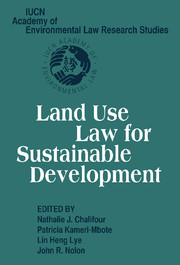Book contents
- Frontmatter
- Contents
- List of Contributors
- Message from Kofi A. Annan, Secretary-General, United Nations
- Foreword by Charles Odidi Okidi and Nicholas Adams Robinson
- Acknowledgments
- Introduction
- Challenges of Environmental Law – Environmental Issues and Their Implications to Jurisprudence
- ONE INTERNATIONAL ISSUES AND LEGAL RESPONSES TO SUSTAINABLE LAND MANAGEMENT
- 1 Is Conservation a Viable Land Usage? Issues Surrounding the Sale of Ivory by Southern African Countries
- 2 Climate Change and Land Use in Africa
- 3 Climate Change Adaptation and Mitigation: Exploring the Role of Land Reforms in Africa
- 4 The Integration of Landscape into Land Use Planning Policy in Relation to the New European Landscape Convention
- 5 EIA Legislation and the Importance of Transboundary Application
- TWO NATIONAL APPROACHES TO LAND USE PLANNING FOR SUSTAINABLE DEVELOPMENT
- Index
5 - EIA Legislation and the Importance of Transboundary Application
Published online by Cambridge University Press: 17 August 2009
- Frontmatter
- Contents
- List of Contributors
- Message from Kofi A. Annan, Secretary-General, United Nations
- Foreword by Charles Odidi Okidi and Nicholas Adams Robinson
- Acknowledgments
- Introduction
- Challenges of Environmental Law – Environmental Issues and Their Implications to Jurisprudence
- ONE INTERNATIONAL ISSUES AND LEGAL RESPONSES TO SUSTAINABLE LAND MANAGEMENT
- 1 Is Conservation a Viable Land Usage? Issues Surrounding the Sale of Ivory by Southern African Countries
- 2 Climate Change and Land Use in Africa
- 3 Climate Change Adaptation and Mitigation: Exploring the Role of Land Reforms in Africa
- 4 The Integration of Landscape into Land Use Planning Policy in Relation to the New European Landscape Convention
- 5 EIA Legislation and the Importance of Transboundary Application
- TWO NATIONAL APPROACHES TO LAND USE PLANNING FOR SUSTAINABLE DEVELOPMENT
- Index
Summary
INTRODUCTION
Many countries in Africa either have adopted environmental impact assessment (EIA) legislation or are in the process of doing so. An EIA is one of the available environmental management tools used to facilitate sound integrated decision making where by environmental considerations are explicitly and systematically taken into account in the planning and development process.
Wood and other authors developed EIA evaluation criteria that are essential elements of an effective EIA. The EIA legislation differs from country to country, and different countries use different approaches. Some legislation is process-driven, other is issue-driven. For instance, South Africa, Namibia, and Swaziland are neighbors, but their EIA legislation differs.
In some instances, developments may also have severe consequences outside the boundaries of states. Such transborder consequences are not always addressed in EIA legislation of individual states. The 1992 Declaration and Treaty of the Southern African Development Community (SADC) provides that natural resources and environmental issues of member countries be addressed in a spirit of cooperation, and some of the SADC protocols refer to the fact that transborder EIAs should be undertaken.
In the absence of an agreement or protocol, a transborder development will have to comply with the legislation of all countries in the transborder frontier. There are already several transboundary projects in Africa, some of which are financed by the World Bank. The lack of knowledge concerning the different countries' EIA legislation and their different applications hampers development projects and conservation of the environment.
- Type
- Chapter
- Information
- Land Use Law for Sustainable Development , pp. 89 - 108Publisher: Cambridge University PressPrint publication year: 2006

